Have you found some weeds with yellow flowers in your yard?
Before you decide what to do with them, it’s important to identify the type of weed you’re dealing with.
Some weeds spread aggressively and need to be dealt with quickly. And depending on the variety, you might need a different method of weed control.
So in this article, I’ll show you how to identify the most common types. And explain what you can do if you find yellow flowering weeds in your garden.
Let’s dive in!
20 Common Weeds With Yellow Flowers
Weeds with yellow flowers are among the most common types of flowering weeds. Here’s how you can identify some of the species you’re most likely to come across:
Yellow Hawkweed (Hieracium caespitosum)
Yellow hawkweed is also known as meadow hawkweed. The weed looks similar to the common dandelion. It flowers from May to July, producing compact clusters of yellow flower heads that grow at the top of bristly stems. A yellow hawkweed plant can produce up to 30 flower stems, each topped by 5-30 flowerheads.
The weed has long, narrow leaves that grow up to 6 inches. Similar to dandelions, the leaves form a basal rosette. But they’re not lobed and have hairs on both surfaces.
Yellow hawkweed is an invasive weed that’s difficult to control. And it’s considered a noxious weed in some US states. It thrives in a range of man-made habitats including meadows and fields. It’s also a pasture that causes problems by forming large monocultures that displace forage plants.
The weed spreads by seed, rhizomes, and creeping stems (stolons). And you’ll usually find yellow hawkweed growing in sunny locations, although it can tolerate some shade.
To control yellow hawkweed, cut the flowers off to prevent the plant from developing seeds and apply a systemic herbicide that can kill the root system.
Golden Clover (Trifolium aureum)
Golden clover flower by Fornax, CC BY-SA 3.0, via Wikimedia Commons
Golden clover is also known as large trefoil and hop clover. It’s a biennial weed that’s native to northwestern Asia and northern Europe. It was introduced to North America in the 19th century where it’s now naturalized.
Golden clover is a yellow clover. Each plant produces numerous flowers that grow on branching stems. The large flowering heads grow at the end of small stalks. And each flower head consists of many tiny yellow flowers clustered together. As they get older, the flowers turn from yellow to brown and become paper-like.
Similar to other species of clover, the leaves of the weed are trifoliate — each consists of 3 leaflets. Each leaflet grows up to ¾-inch long and has fine-toothed edges and a rounded tip.
Golden clover is a common garden weed. You’ll often see it spreading through thin and patchy lawns. As well as growing in fields, waste areas, and along roadsides.
It’s easiest to control golden clover with a broadleaf herbicide.
Dandelions (Taraxacum)
Dandelions are one of the most common weeds to find growing on your lawn.
There are more than 250 types of dandelions. And they all have a similar distinctive-looking flowerhead. Most dandelions are weeds with yellow flowers. But you can find dandelions with pink and white flowers as well.
Most dandelions bloom in the spring. The flowerhead consists of numerous florets and grows at the end of a long stalk. When dandelions set seed, the flowerhead is replaced by a seed puff of small seeds that are easily dispersed by the wind.
Dandelions have long, narrow, lobed leaves that grow in a basal rosette. Sometimes the leaves are hairy and sometimes they’re smooth.
Dandelions can be removed using a corkscrew weeder that removes the taproot or you can use a selective herbicide.
Common Mullein (Verbascum thapsus)
Common mullein is a giant weed that’s native to Asia, North Africa, and Europe. It’s an introduced plant in Australia and North America, where it’s now considered an invasive weed in many states.
The plant is biennial. In the first year, the weed grows a rosette of large leaves. In the second year, a long central stem grows up to 7 feet tall. From June to September the weed flowers. Developing a long spike of small yellow flowers at the top of the stem (1).
Common mullein has giant oval-shaped leaves that grow up to 12 inches long and 5 inches wide. The leaves are thick, grey-green, and covered in fuzzy hairs. The wooly feel of the leaves is responsible for another of the weed’s common names, woolly mullein.
To control the weed you can dig common mullein from the ground using a shovel.
Spiny Sowthistle (Sonchus asper)
This annual weed is also known as prickly sowthistle and spiny-leaved sowthistle. The plant flowers from June to August with yellow flowers that look similar to a dandelion.
Spiny sowthistle isn’t a thistle. But it does share some similarities. The weed has prickly leaves. And develops a basal rosette in the early stages of growth that looks similar to thistle plants.
Spiny sowthistle is often encountered as a desert weed. But it’s also a common and prolific weed in gardens that are uncared for. If you find this weed growing in your yard it’s important not to let it go to seed. The seeds easily spread by wind and water, and the weed can quickly take over an area if left unchecked.
To control spiny sowthistle, cut the weed before it flowers or pull it from the ground.
Creeping Buttercup (Ranunculus repens)
You can easily identify the creeping buttercup by its glossy, golden-yellow flowers. Each flower has 5 petals and grows at the end of a thin, green stalk.
The weed can grow up to 20 inches tall. And features compound basal leaves that consist of 3 lobed leaflets that grow up to 8 cm long. Leaves higher on the stem are smaller, narrower, and often simple. Both the leaves and the stems are covered with fine hairs.
Creeping buttercup grows in a range of conditions. But it thrives in poorly-drained soil, quickly colonizing waterlogged areas of your lawn and garden.
The weed spreads by sending out runners that root in the soil at the nodes. This makes it difficult to remove the whole plant by hand. It’s easiest if you deal with the weed before it has a chance to spread.
Butterweed (Packera glabella)
Also called yellowtop and cressleaf groundsel, butterweed is an annual weed that’s native to North America. Butterweed likes to grow in high humidity. And you’ll often find this weed growing in large clumps near swamps, ponds, streams, and forests. As well as in areas of disturbed ground such as roadsides and agricultural fields.
The weed grows a basal rosette of leaves in the early stages of its development. Before sending up a hollow stem in the spring with a panicle of yellow daisy-like flowers at the top.
Butterweed flowers from April to June. And each yellow flower has between 5-15 florets surrounding a golden yellow disk floret in the center.
The weed has alternate, green leaves that can grow up to 10 inches long. Becoming smaller the closer you get to the top of the central stem.
It’s easiest to kill butterweed during the rosette growth stage by spraying it with 2,4-D.
Goldenrod (Solidago sp.)
Goldenrod is a perennial yellow wildflower that some people choose to grow in their gardens. But the plant can also be an invasive weed that spreads aggressively via seeds and rhizomes. The weed grows in large clumps and outcompetes other plants in your yard.
In the United States, there are between 60 and 70 species of goldenrod. All species have a distinctive plume of bright yellow flowers that’s highly visible in the summer landscape. The flowers continue until the fall.
Goldenrod grows best in full sun and like well-draining soil. It typically grows tall and thin, growing between 1.5-5 feet tall, with long, green leaves that grow alternately from the stem.
the easiest way to control goldenrod is by spraying the weed with a broadleaf herbicide.
Ragwort (Jacobaea vulgaris)
Ragwort is also known by the names tansy ragwort and common ragwort. The plant is native to northern Eurasia, where it’s a common wildflower. It’s now distributed in many parts of the world where it grows as a weed.
In the Northern Hemisphere, ragwort blooms from June to November. The weed has bright yellow flowers that grow in flat-topped clusters at the end of long stalks.
Ragwort is usually a biennial weed. Developing a basal rosette of ruffled leaves when the plant first emerges. In the second year, the long, erect stems grow. The stems are hairless. And the weed has pinnately lobed leaves with a blunt end lobe.
The weed is invasive in some areas. Once ragwort becomes established it can be challenging to control. The weed produces thousands of seeds that spread into nearby fields and gardens, enabling the plant to easily spread.
Ragwort is sometimes considered a noxious weed because it’s poisonous to horses and cattle when ingested in large quantities.
Garden Loosestrife (Lysimachia vulgaris)
Garden loosestrife is also known as yellow loosestrife and willowweed. Originally introduced to North America as an ornamental plant, it now grows wild. And it’s considered an invasive and noxious weed in many parts of the United States.
The problem?
It’s a tall weed that grows up to 6 feet or more and forms dense stands. This allows the weed to outcompete and displace native plants and wildlife as it spreads and takes over large areas.
The weed blooms in the summer. Developing primrose-like flowers that grow in clusters at the top of upright, hairy stems. The flowers are yellow with orange-brown edges and consist of 5 petals and sepals.
Garden loosestrife spreads through seeds and rhizomes. The rhizomes create a dense mat underground that extends for 15 feet, making the weed difficult to remove once it’s established. The weed likes to invade wet areas. So it’s common to find it in marshes and wetlands. As well as around the edges of streams, ponds, and lakes.
To control garden loosestrife it’s best to use a systemic herbicide before the plant sets seed.
Cinquefoil (Potentilla)
There are over 300 different species of cinquefoil. Most of them are herbaceous perennial weeds that grow in the temperate zones of the northern hemisphere.
Cinquefoils are flowering weeds. The majority of cinquefoil plants produce a single, 5-petalled, yellow flower. But some species have pink, white, or red flowers.
Most species of cinquefoil have leaves that consist of 5 leaflets, although some species have a different number.
Cinquefoils are sometimes confused with strawberry plants and have similar-looking fruit. But the red berries this yellow flowering weed produces are dry and inedible. Resulting in the name given to some cinquefoil species of ‘barren strawberry’.
You can pull cinquefoil plants from the ground, but they have a long taproot and you need to remove all of it. Use a shovel or spade to dig out any leftover root pieces.
Yellow Woodsorrel (Oxalis stricta)
Yellow woodsorrel is also known as common yellow oxalis and lemon clover. The plant is native to North America and parts of Eurasia, where it’s common to find it growing in meadows, woodlands, and man-made habitats. Yellow woodsorrel is a common lawn weed and you’ll often find it spreading through gardens.
When it blooms from July to October, yellow woodsorrel produces small yellow flowers at the end of long stalks. Each flower has 5-petals. The flowers can occur on their own or in clusters of up to 5.
After the weed blooms, it produces elongated and ridged seed pods. Each pod contains around 50 seeds. When fully mature, the seed pods are sensitive to touch and explode easily, ejecting seeds up to 4 meters from the parent plant.
To further help you with identification, look at the leaves. They grow alternately from the stem. And each leaf consists of 3 heart-shaped leaflets, similar to many other species of Oxalis.
Another interesting fact:
After you remove this weed, you don’t have to throw it away. Yellow woodsorrel is an edible weed. And you can eat all parts of the plant. The flowers and leaves have a tangy flavor. And you can use them in a salad or chew them raw.
Creeping Jenny (Lysimachia nummularia)
Creeping Jenny is also called Moneywort. It’s a low-growing perennial weed. And it spreads rapidly in areas where grass won’t grow because of shade and excessive moisture. Because this weed acts as a ground cover, some gardeners welcome creeping Jenny in their garden and actively cultivate it.
Creeping Jenny spreads through creeping stems called stolons. Where the stem joints touch the soil they develop roots. And as this weed covers the ground, it crowds out and displaces other plants.
In early summer, creeping Jenny blooms, with small, bright yellow flowers covering the stems.
Another thing to look out for when identifying this weed is the bright green, scallop-edged leaves that are kidney-shaped or round.
Creeping Jenny is hard to control, so it’s best to act as soon as you identify the plant. A combination of pulling the weed by hand and applying herbicides can get the job done, but it may take two seasons to eradicate it.
Burr Medic (Medicago polymorpha)
MEDICAGO POLYMORPHA FLOWERS BY HARRY ROSE
Burr medic is well-known for the spiky sticker balls it distributes about your lawn after it produces seeds. But before the burrs, the weed develops small yellow flowers between March and June.
Burr medic has green, serrated-edged leaves that consist of 3 leaflets and look similar to clover, giving rise to another common name for this plant, bur clover.
MEDICAGO POLYMORPHA HARRY ROSE
The weed has reddish-purple stems (stolons) that creep across your lawn, growing up to 30 inches long. The stems root from nodes that touch the ground.
Regular mowing can control burr medic and stop the weed from spreading its seeds.
Other similar species with yellow flowers include cut-leaved medic (M. laciniata), woolly medic (M. minima), spotted burr medic (M. arabica), and barrel medic (M. truncatula).
Bur Buttercup (Ceratocephala testiculata)
BUR BUTTERCUP BY ANDREY ZHARKIKH
Bur buttercup is also called curveseed butterwort. You’ll often find this summer-annual weed growing on your lawn and planting beds.
Bur buttercup is a low-growing weed that leaves prickly stickers when it’s time to spread its seed. In early spring, the seeds germinate, and the plant starts to grow.
MATT LAVIN FROM BOZEMAN, MONTANA, USA, CC BY-SA 2.0, VIA WIKIMEDIA COMMONS
The weed has light-green leaves with white hairs that look like antlers. The stalks grow beyond the leaves and are leafless, each culminating in a small yellow flower that appears within a few weeks of germination. The weed grows fast, and the stickers quickly follow the flowers. By early summer, the leaves dry out and begin turning brown.
Bur buttercup is easy to control. You can hoe, dig, or pull out the weeds. If you have a large area to treat, broadleaf herbicide is effective.
Prickly Sida (Sida spinosa)
Also called tea weed, prickly sida produces light yellow flowers that grow from the leaf axils when the plant blooms from mid-summer to early fall.
The weed grows up to 3 feet tall and has green, lanceolate to heart-shaped leaves connected to the branched stems by petioles. A sharp spine at the base of the leaves gives the plant its name. Fine white hairs cover the leaves and stems, feeling soft when you touch the plant.
SIDA SPINOSA LEAVES BY NY STATE IPM PROGRAM
Prickly sida thrives in moist, fertile soil and full to partial sun and is one of the most troublesome weeds on agricultural land in the southern states.
Controlling prickly sida can be challenging. Some post-emergent herbicides can do the job, but spray the weeds early before they grow beyond 3 inches tall for the best results.
Common Purslane (Portulaca oleracea)
Common purslane is an annual broadleaf weed that grows low to the ground and develops small yellow flowers (2) when it blooms from late spring through late summer.
You can identify this weed by the smooth, succulent, red stems that grow along the ground from a central taproot forming a mat that can stretch for 2-3 feet in all directions.
Flat, paddle-shaped leaves grow from the stems, and the flowers grow at the tips. The flowers quickly give way to seedpods that contain black/brown seeds that are released when mature, as the seedpods burst open.
To control purslane, deal with it before the seeds spread. You can pull the weed from the ground, but ensure that no pieces of roots or stems are left behind because the plant can grow back.
Yellow Burr Weed (Amsinckia sp.)
Yellow burr weed is native to North America but now grows in many other parts of the world. The weed produces many small yellow flowers in a curved spike at the end of branches.
Yellow burr weed grows over 2 feet tall, with an erect stem that’s covered in bristles. The leaves of the plant are oval-shaped and dark green to grey-green. Leaves in the basal rosette grow up to 6 inches long and 1 1/2- inches wide. With alternately growing leaves on the stem that are stalkless. The leaves are covered in short, stiff hairs, and feel rough when you touch them.
AMSINCKIA GRANDIFLORA BY JOHN RUSK
Four seeds form on each flower. The seeds are contained in a husk that’s covered with spiky bristles — the burr. When ripe, the seeds fall to the ground. Because the burrs are sticky, they attach to clothing, shoes, and animal fur, and are easily transported to new locations.
Repeated cultivation can be effective at controlling this weed over a small area. For larger infestations use chemical herbicides.
Creeping Water Primrose (Ludwigia peploides)
LUDWIGIA PEPLOIDES BY MICHAEL GRAS, M.ED.
Also called floating primrose willow, creeping water primrose is a flowering weed in the evening primrose family. It’s native to South and Central America. But you can now find it all over the United States and many other parts of the world.
In North America, the weed blooms in the summer. The bright, yellow flowers have 5 petals and grow about 1-2 inches in diameter. The flowers grow on stalks that connect to the stem at the leaf axils.
WATER PRIMROSE WITH REDDISH STEMS BY PERE IGOR, CC BY-SA 3.0, VIA WIKIMEDIA COMMONS
This weed likes wet conditions and you’ll find it growing in muddy soil and shallow water. The weed sends out long stems that can float, creating dense mats that clog waterways. This gives creeping water primrose a reputation as an aquatic noxious weed.
The weed is potentially invasive. And it can spread aggressively in wetlands. You’ll often see it along river banks and the edges of ponds, as well as wet meadows.
Physical control of creeping water primrose is challenging as the weed regrows from any root fragments in the soil. Chemical herbicides are the most effective way of killing this plant.
Goat Head Weed (Tribulus terrestris)
Goat head weed is a notorious noxious weed. It also goes by the names puncturevine, devil’s thorn, and bindii. The weed has sharp thorns on its fruit that can puncture bare feet, thin shoes, bicycle tires, and animal hooves. This helps the plant to spread as the seeds are carried to a new place.
Goat head weed is a very fast-growing weed. After germinating in the spring, it quickly develops deep roots and sends out long stems that creep along the ground. As they spread they form a dense mat.
The stems grow from a central tap root, are covered in hairs, and can reach up to 5 feet long. Within a few weeks of germinating, the weed produces small yellow flowers with 5 petals (3).
Pre-emergent herbicides can prevent the seeds from developing after germination. To kill existing plants you can use a systemic weedkiller.
How Do I Get Rid Of Yellow Weeds In My Lawn?
Three of the best ways to get rid of yellow weeds in your lawn are to pull them by hand, use a post-emergent weed killer, and apply a pre-emergent herbicide. Depending on the type of yellow weed in your lawn, some methods will be more suitable than others. So accurate identification of the yellow weed is an important first step.
Hand-pulling is an effective way of clearing some weeds. Particularly weeds with shallow root systems. But for weeds with deep and extensive root systems, it can be difficult, even when using a weeding tool to help you. Weeds that regrow from pieces of root left behind in the soil are even more challenging. And for large infestations, it may be impractical.
Using a selective weed killer that won’t harm your lawn is a popular choice with many homeowners. You can spray a large area quickly and prevent the weed from regrowing.
If the yellow flowering weed has already set seed, then it’s a good idea to use a pre-emergent herbicide. When applied to the ground in the weeks before seed germination you can prevent the weeds from sprouting. Pre-emergent herbicides are usually used in spring or fall, depending on the weed type.
You Might Also Like:
References:
- Verbascum Thapsus – https://plants.ces.ncsu.edu/plants/verbascum-thapsus/
- Common Purslane – https://navajorange.nmsu.edu/detail.php?id=120
- Puncturevine (Tribulus terrestris) – https://ipm.ucanr.edu/PMG/WEEDS/puncturevine.html
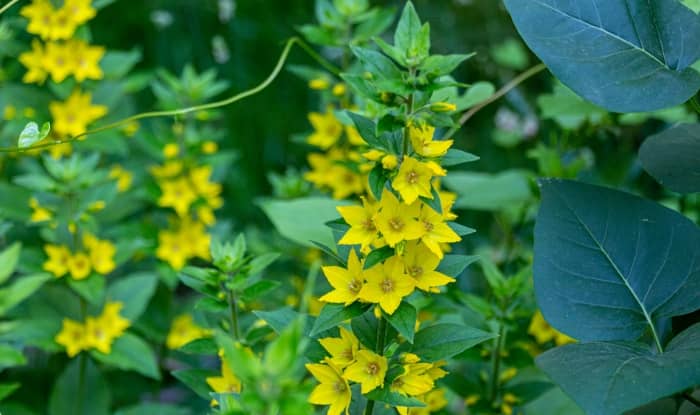
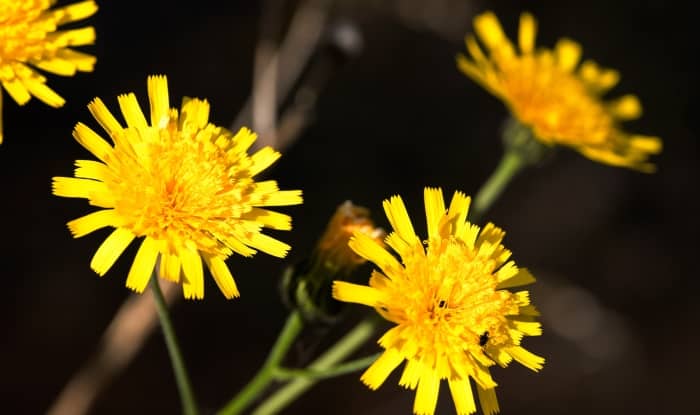
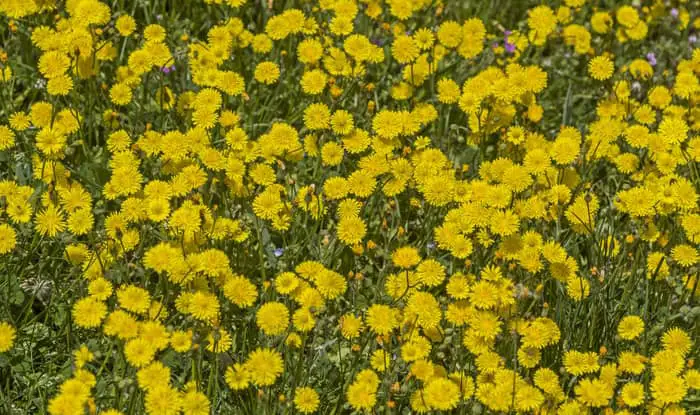
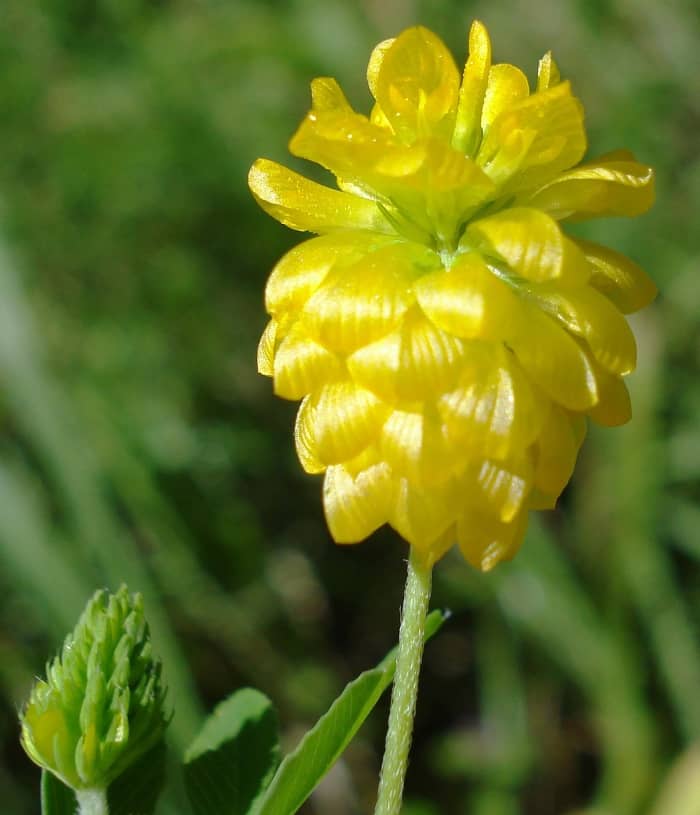

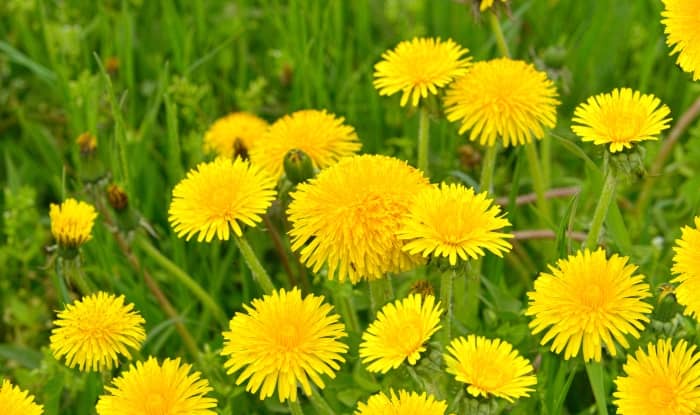
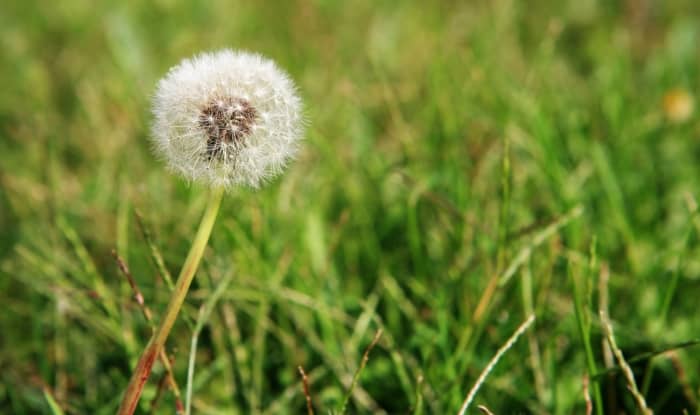

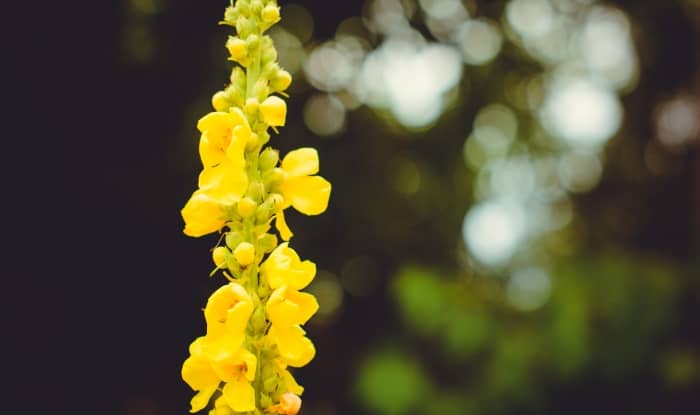
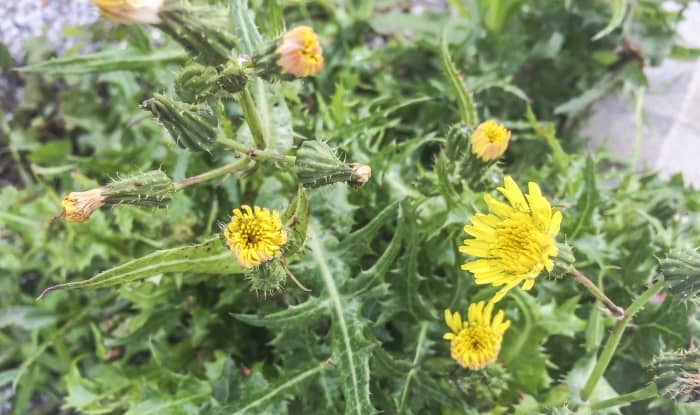
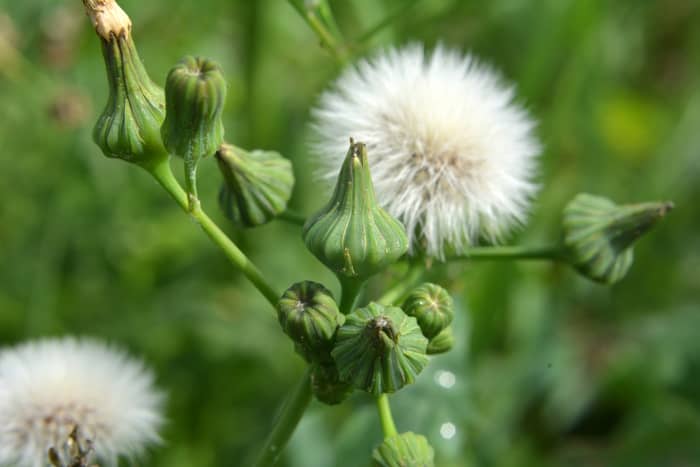

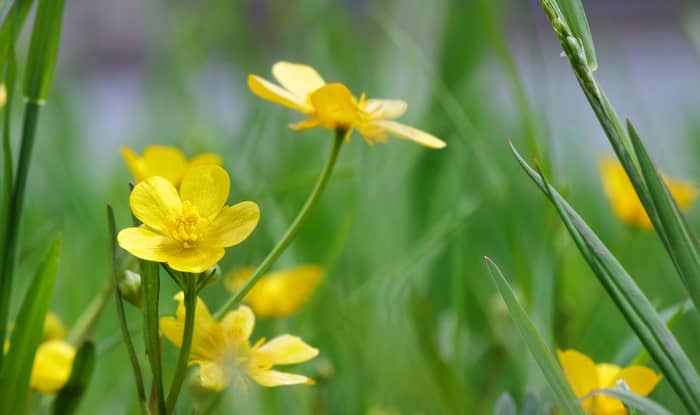
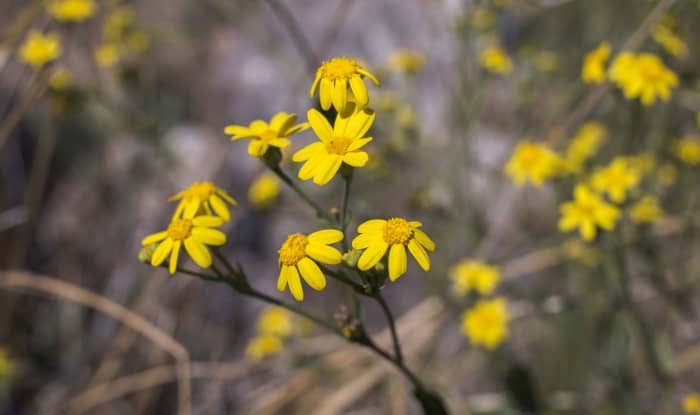
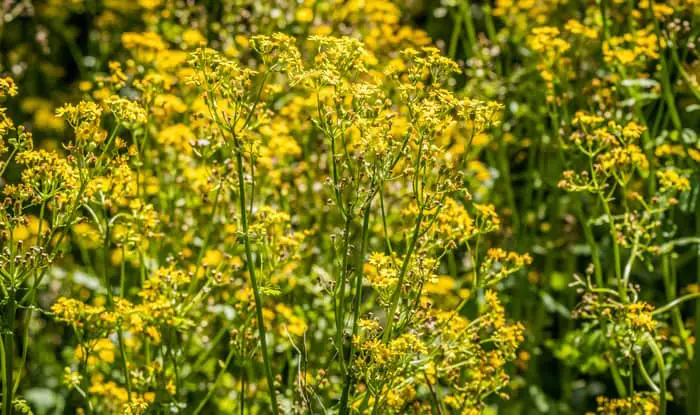

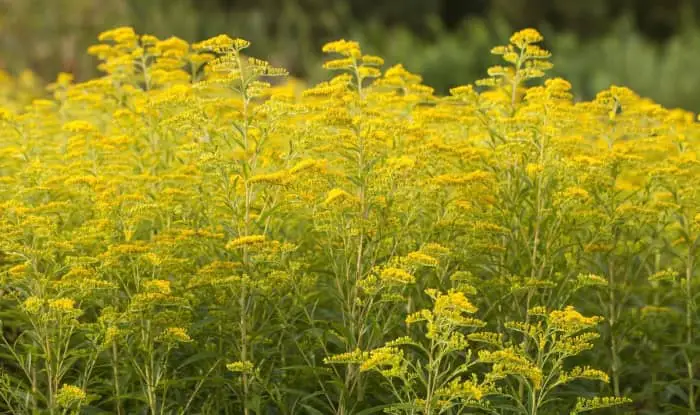
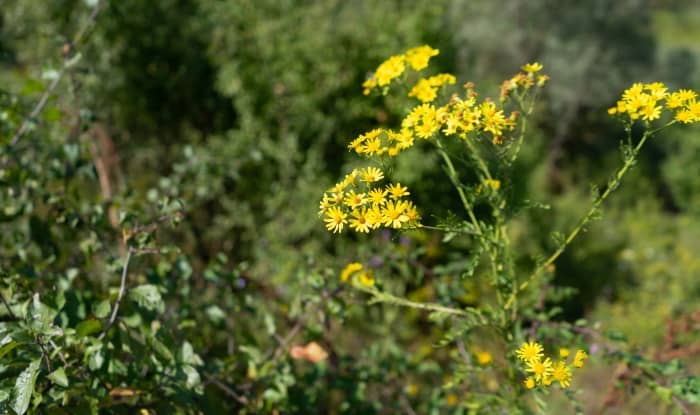
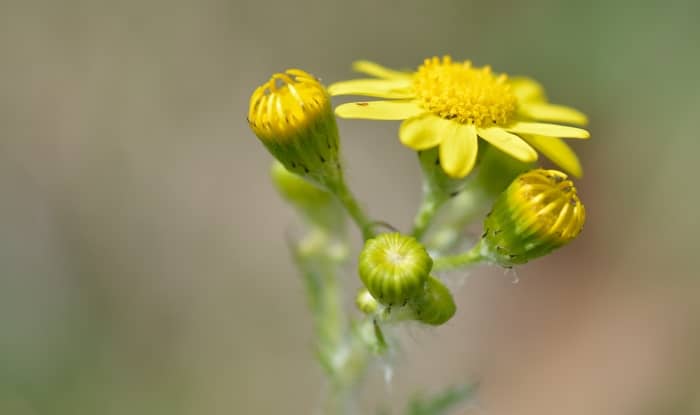
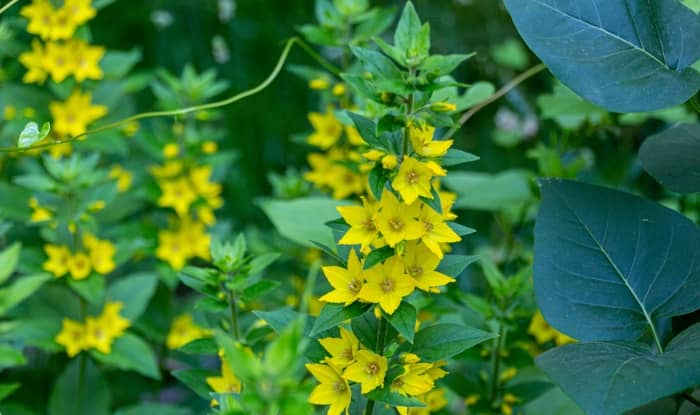
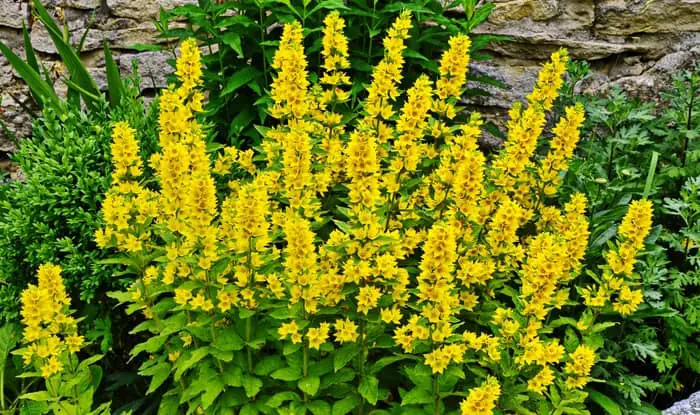
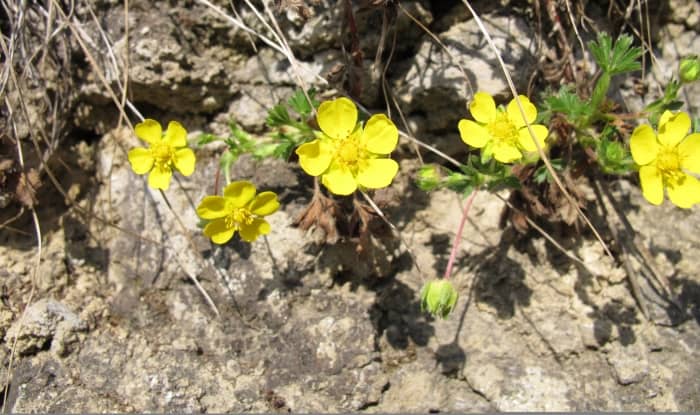

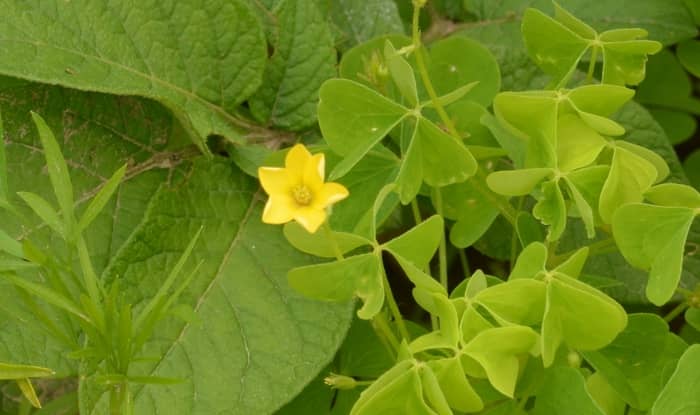
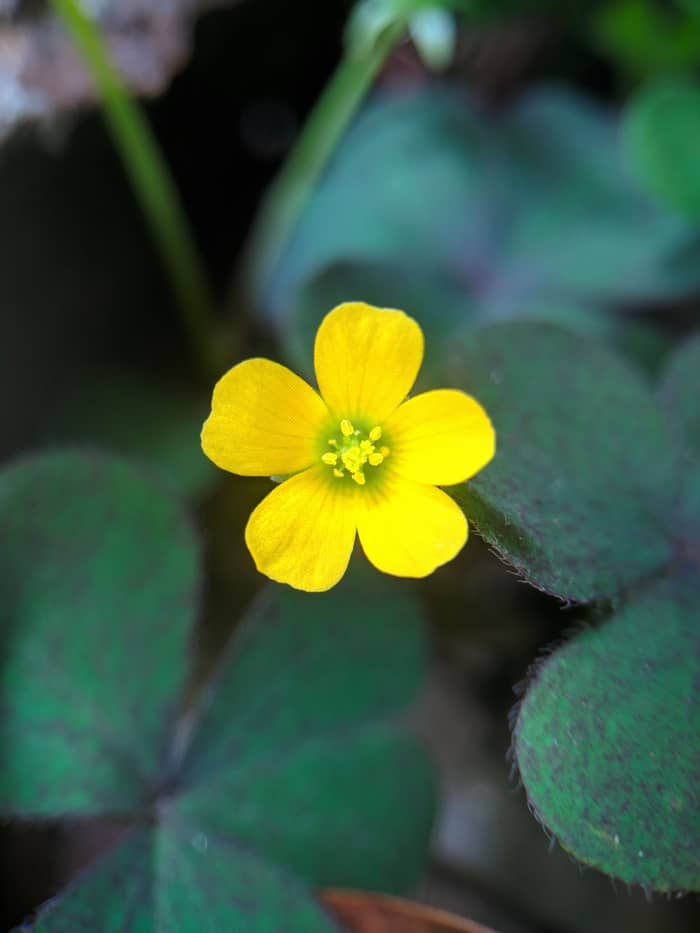
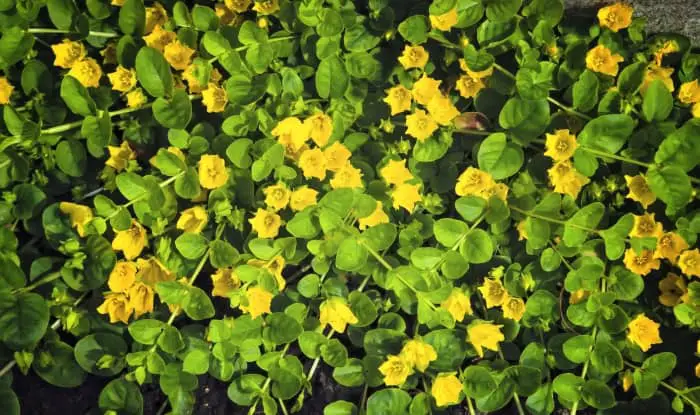
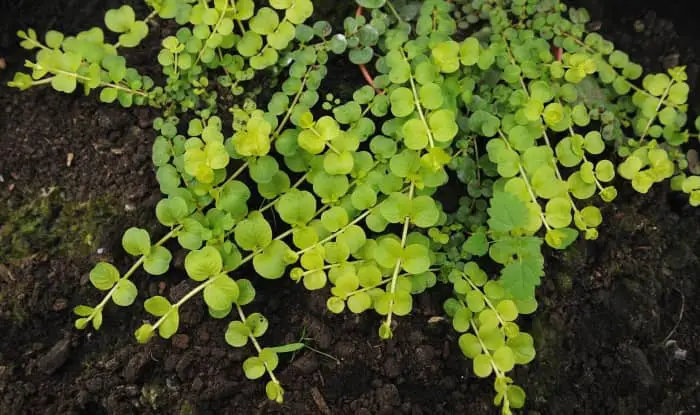
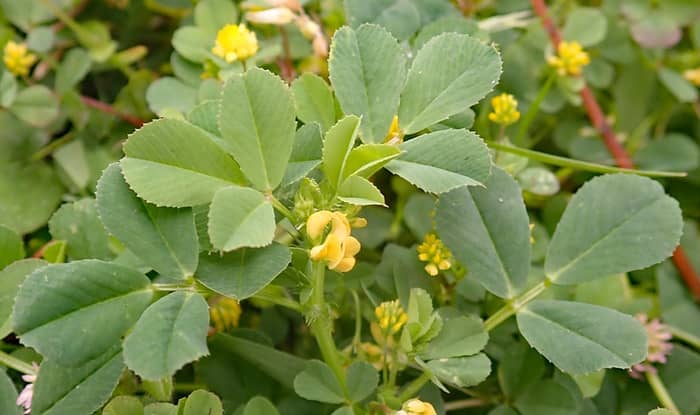
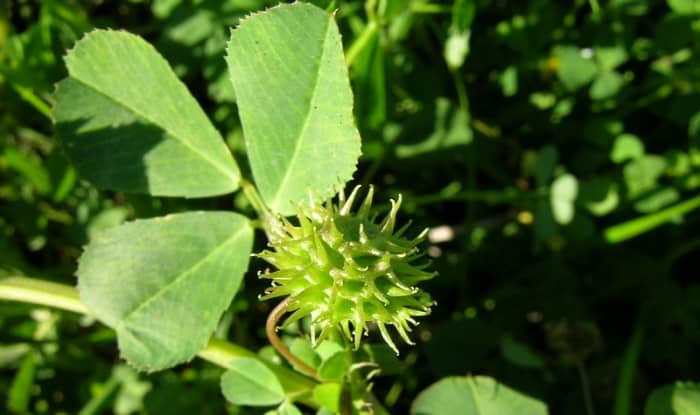

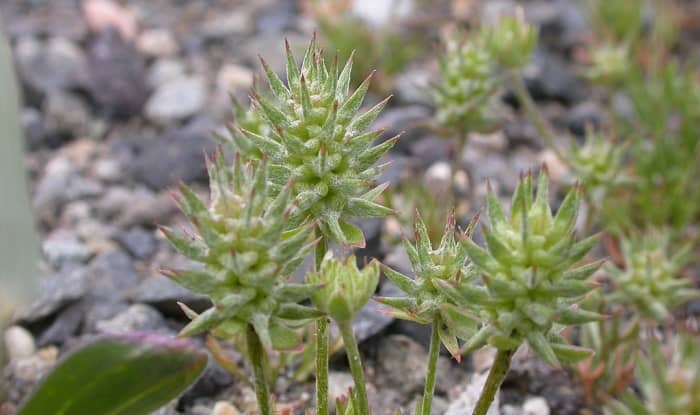
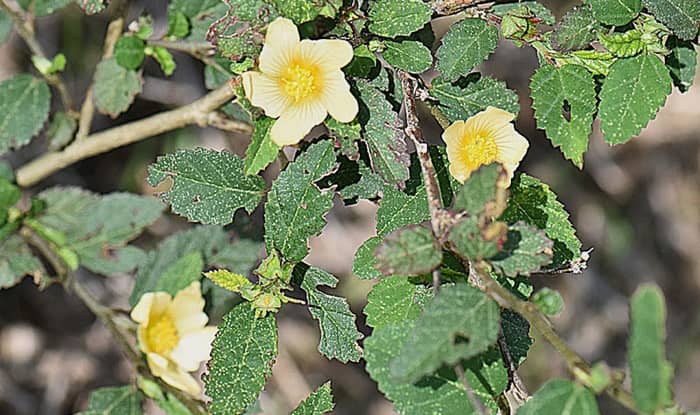

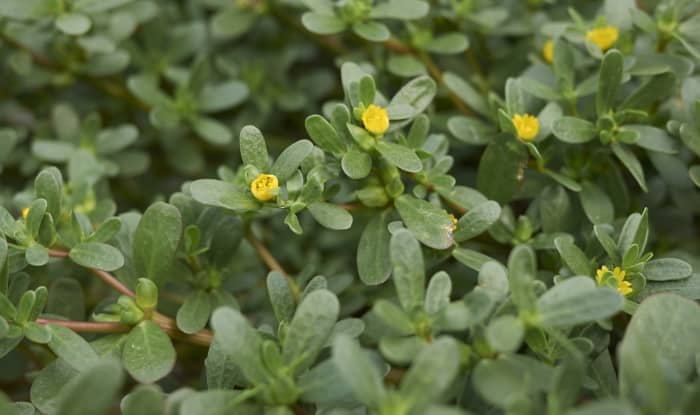
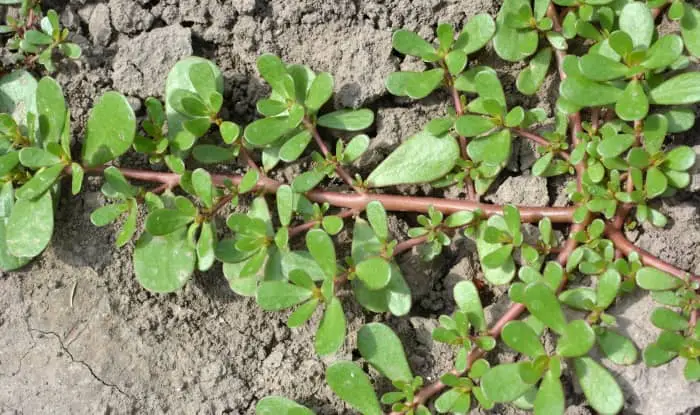
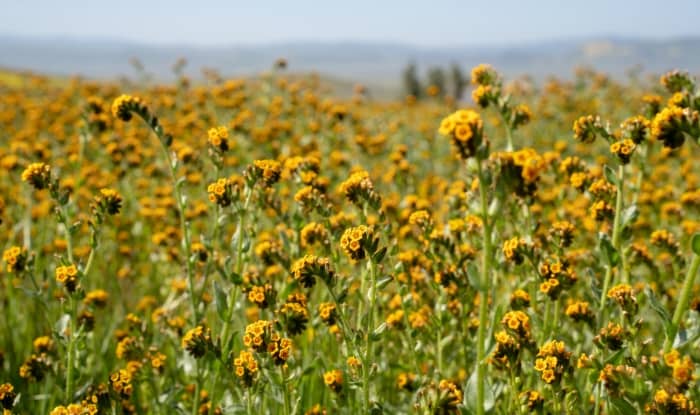
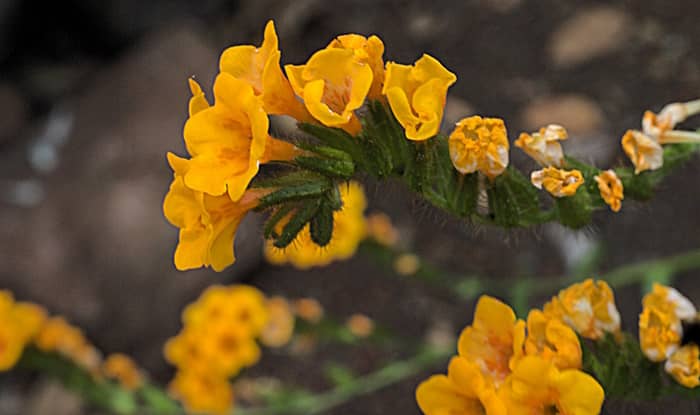
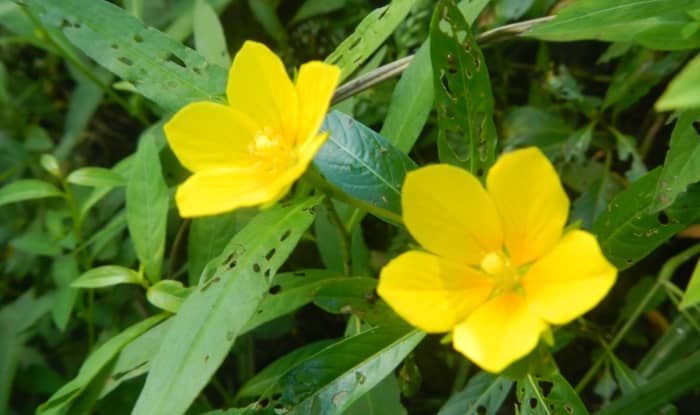
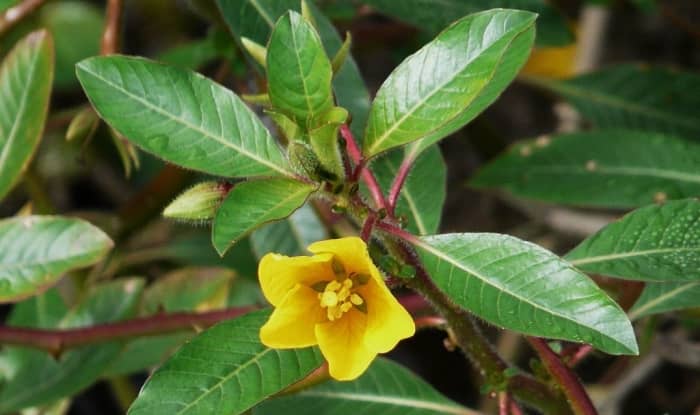
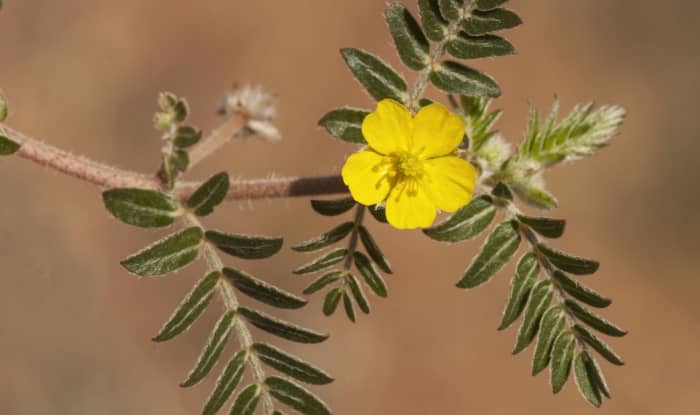
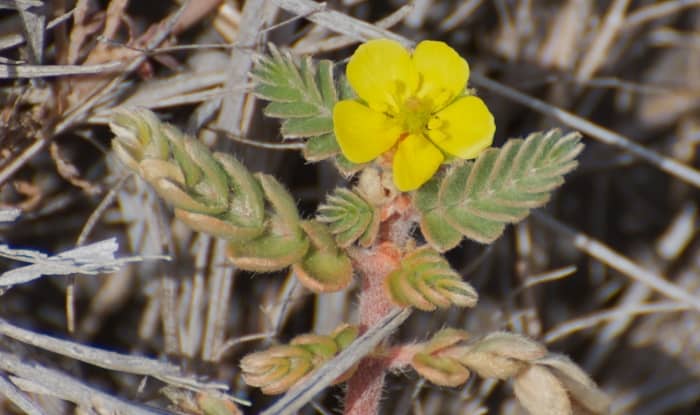
clumps of dark red stems with very small yellow flowers all over front garden which is pebbled. what is this weed please?